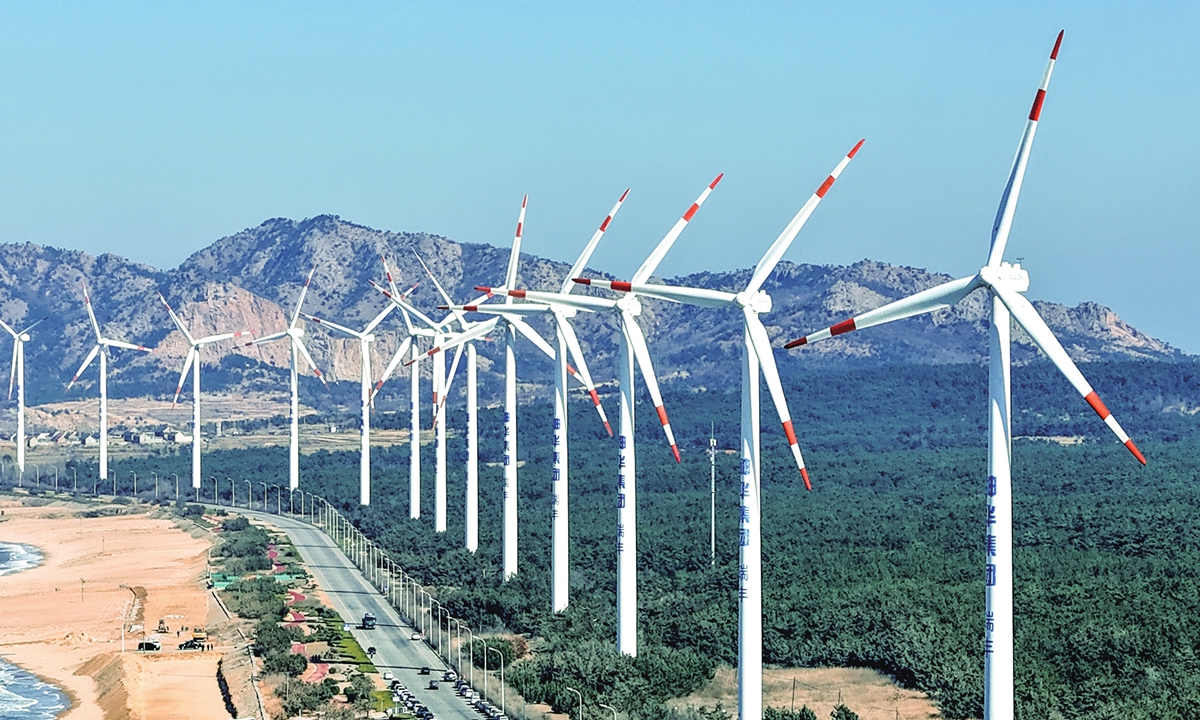China’s green development boosts its economic resilience, vitality
China's green development boosts its economic resilience, vitality Global Times


China’s Green Development and Ecological Civilization

A photo taken on March 19, 2024 shows wind turbines in a coastal area of Rongcheng city, East China’s Shandong Province. The city, relying on its rich coastal wind energy resources, vigorously promotes the development of green and clean energy industries and optimizes the energy structure, in a bid to achieve ecological protection and sustainable development. Photo: VCG
Introduction
China’s green development and ecological civilization are integral parts of its national strategy, driven by the need to transform its economic structure, develop a competitive green and low-carbon industry, and achieve high-quality growth. These efforts align with the Sustainable Development Goals (SDGs) and have significantly enhanced the resilience and vitality of China’s economy.
Challenges and Strategies
As the world’s largest developing nation, China faces challenges such as a large population, limited resources, and a fragile ecosystem. To address these challenges, China has embraced ecological civilization as a means to solidify the foundation for its modernization and promote inclusive economic and social development.
China’s comprehensive strategies to protect and restore ecosystems include afforestation and combating desertification. These efforts have resulted in continuous growth in forest coverage over the past three decades and a reduction in deserts and sandy lands. By transforming natural and ecological wealth into economic and social prosperity, China has strategically fueled its high-quality development.
Achievements in Green Development
Contrary to the narrative propagated by some Western countries, China has successfully integrated economic development and environmental protection. From 2012 to 2021, China supported an average economic growth of 6.6 percent per year while reducing carbon dioxide emissions per unit of GDP by approximately 34.4 percent and energy consumption per unit of GDP by 26.4 percent. China now creates one-quarter of the world’s new green lands, showcasing its commitment to sustainable development.
China’s green development has led to the growth of green industries and new productive forces, becoming a highlight of its economy in the new era. The country has made significant advancements in pollution control, ecological management, and the integration of emerging technologies like big data, AI, and advanced telecommunications. The energy conservation and environmental protection industry has become a substantial force in China’s green economy.
The Path to Ecological Civilization
China’s promotion of ecological civilization signifies a reflection on and critique of industrial civilization, making it an essential ecological feature of its modernization. By using ecological civilization and green development as strategic pathways and engines of its development, China has reshaped and led the new economic pattern of modern China. This comprehensive green transition represents the most extensive and profound socioeconomic transition toward sustainability in the 21st century.
Global Impact and Lessons
China’s green development not only expands the global green footprint but also triggers a new round of industrial transformation. Its contribution to global renewable energy installation and carbon emissions reduction highlights its role as a major global player. China’s path to green development offers lessons for developing countries on achieving modernization without relying on exploitative practices.
Conclusion
The narrative of China’s so-called “overcapacity” is a discrediting tactic used by the US and Western countries to suppress China’s development. China’s pursuit of ecological civilization represents a new trend in the evolution of human civilization. Embracing this new civilization will lead the way in shaping its future.
Huang Chengliang is a research fellow at the research institute for Eco-civilization, Chinese Academy of Social Sciences. bizopinion@globaltimes.com.cn
SDGs, Targets, and Indicators
-
SDG 7: Affordable and Clean Energy
- Target 7.2: By 2030, increase substantially the share of renewable energy in the global energy mix.
- Indicator: The article mentions China’s promotion of green and clean energy industries, such as wind turbines and photovoltaic (PV) systems, which contribute to the development of renewable energy sources.
-
SDG 9: Industry, Innovation, and Infrastructure
- Target 9.4: By 2030, upgrade infrastructure and retrofit industries to make them sustainable, with increased resource-use efficiency and greater adoption of clean and environmentally sound technologies and industrial processes.
- Indicator: The article highlights China’s advancements in green technology and the development of green industries, which demonstrate the country’s efforts to achieve sustainable infrastructure and promote clean technologies.
-
SDG 11: Sustainable Cities and Communities
- Target 11.6: By 2030, reduce the adverse per capita environmental impact of cities, including by paying special attention to air quality and municipal and other waste management.
- Indicator: The article mentions China’s breakthroughs in key technologies for environmental management, such as flue gas control and water pollution control, which contribute to improving air quality and waste management in cities.
-
SDG 13: Climate Action
- Target 13.2: Integrate climate change measures into national policies, strategies, and planning.
- Indicator: The article discusses China’s efforts to reduce carbon dioxide emissions per unit of GDP and energy consumption per unit of GDP, indicating the integration of climate change measures into national policies and strategies.
-
SDG 15: Life on Land
- Target 15.2: By 2020, promote the implementation of sustainable management of all types of forests, halt deforestation, restore degraded forests, and increase afforestation and reforestation globally.
- Indicator: The article mentions China’s efforts in afforestation and combating desertification, resulting in continuous growth in forest coverage over the past three decades, which aligns with the target of promoting sustainable forest management.
Table: SDGs, Targets, and Indicators
| SDGs | Targets | Indicators |
|---|---|---|
| SDG 7: Affordable and Clean Energy | Target 7.2: By 2030, increase substantially the share of renewable energy in the global energy mix. | The article mentions China’s promotion of green and clean energy industries, such as wind turbines and photovoltaic (PV) systems, which contribute to the development of renewable energy sources. |
| SDG 9: Industry, Innovation, and Infrastructure | Target 9.4: By 2030, upgrade infrastructure and retrofit industries to make them sustainable, with increased resource-use efficiency and greater adoption of clean and environmentally sound technologies and industrial processes. | The article highlights China’s advancements in green technology and the development of green industries, which demonstrate the country’s efforts to achieve sustainable infrastructure and promote clean technologies. |
| SDG 11: Sustainable Cities and Communities | Target 11.6: By 2030, reduce the adverse per capita environmental impact of cities, including by paying special attention to air quality and municipal and other waste management. | The article mentions China’s breakthroughs in key technologies for environmental management, such as flue gas control and water pollution control, which contribute to improving air quality and waste management in cities. |
| SDG 13: Climate Action | Target 13.2: Integrate climate change measures into national policies, strategies, and planning. | The article discusses China’s efforts to reduce carbon dioxide emissions per unit of GDP and energy consumption per unit of GDP, indicating the integration of climate change measures into national policies and strategies. |
| SDG 15: Life on Land | Target 15.2: By 2020, promote the implementation of sustainable management of all types of forests, halt deforestation, restore degraded forests, and increase afforestation and reforestation globally. | The article mentions China’s efforts in afforestation and combating desertification, resulting in continuous growth in forest coverage over the past three decades, which aligns with the target of promoting sustainable forest management. |
Behold! This splendid article springs forth from the wellspring of knowledge, shaped by a wondrous proprietary AI technology that delved into a vast ocean of data, illuminating the path towards the Sustainable Development Goals. Remember that all rights are reserved by SDG Investors LLC, empowering us to champion progress together.
Source: globaltimes.cn

Join us, as fellow seekers of change, on a transformative journey at https://sdgtalks.ai/welcome, where you can become a member and actively contribute to shaping a brighter future.







